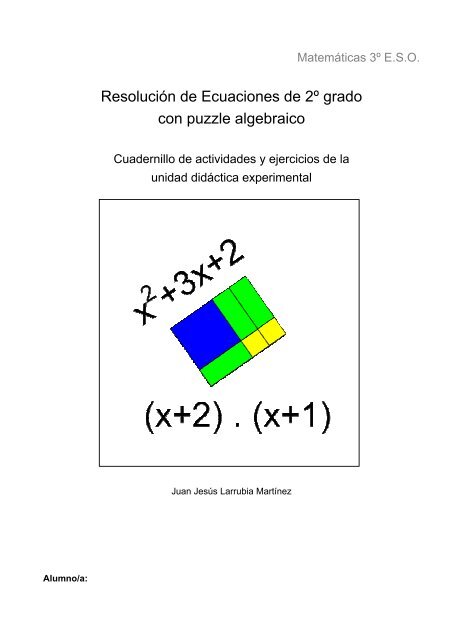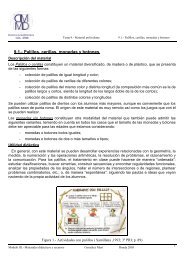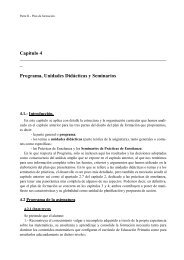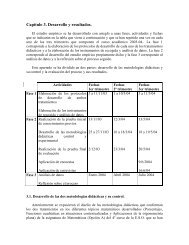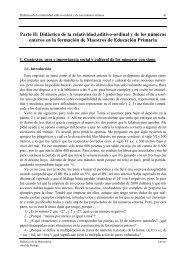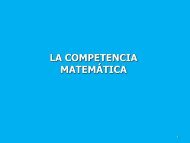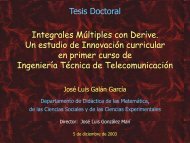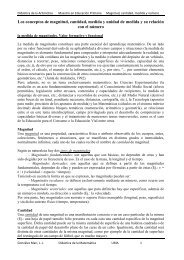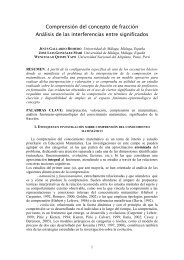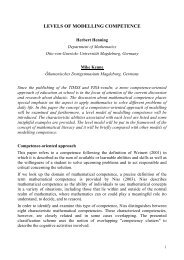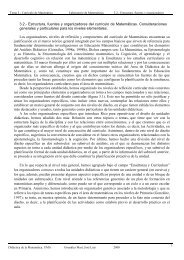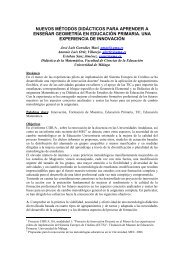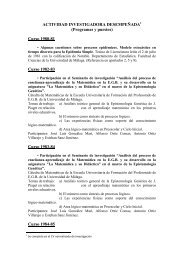Resolución de Ecuaciones de 2º grado con puzzle ... - CPR Ceuta
Resolución de Ecuaciones de 2º grado con puzzle ... - CPR Ceuta
Resolución de Ecuaciones de 2º grado con puzzle ... - CPR Ceuta
Create successful ePaper yourself
Turn your PDF publications into a flip-book with our unique Google optimized e-Paper software.
Matemáticas 3º E.S.O.<br />
<strong>Resolución</strong> <strong>de</strong> <strong>Ecuaciones</strong> <strong>de</strong> <strong>2º</strong> <strong>grado</strong><br />
<strong>con</strong> <strong>puzzle</strong> algebraico<br />
Cua<strong>de</strong>rnillo <strong>de</strong> activida<strong>de</strong>s y ejercicios <strong>de</strong> la<br />
unidad didáctica experimental<br />
Juan Jesús Larrubia Martínez<br />
Alumno/a:
Cua<strong>de</strong>rnillo <strong>de</strong> activida<strong>de</strong>s y ejercicios.<br />
J.J. Larrubia.<br />
____________________________________________________________________________________________________________________________<br />
1. Clasifica las siguientes ecuaciones <strong>de</strong> segundo <strong>grado</strong> por su expresión algebraica, <strong>de</strong> acuerdo al<br />
esquema visto en clase.<br />
Clasificación<br />
<strong>Ecuaciones</strong> <strong>de</strong> <strong>2º</strong> <strong>grado</strong><br />
por su expresión algebraica<br />
Ecuación en forma <strong>de</strong><br />
BINOMIO AL CUADRADO<br />
Ecuación en forma <strong>de</strong><br />
producto <strong>de</strong> dos factores o<br />
FACTORIZADA<br />
Ejemplo: (x-2).(x+3)=0<br />
Ecuación en forma<br />
GENERAL<br />
<strong>con</strong><br />
término in<strong>de</strong>pendiente<br />
Ejemplo: (x-2) 2 -4=0<br />
sin<br />
término in<strong>de</strong>pendiente<br />
Ejemplo: (x+3) 2 =0<br />
incompleta<br />
completa<br />
Ejemplo: x 2 -5x+6=0<br />
Sin<br />
Término in<strong>de</strong>pendiente<br />
Ejemplo: x 2 +4x=0<br />
Sin<br />
Término en X<br />
Ejemplo: x 2 -9=0<br />
<strong>Ecuaciones</strong> <strong>de</strong> <strong>2º</strong> <strong>grado</strong><br />
Tipo o forma <strong>de</strong> la ecuación <strong>de</strong> <strong>2º</strong> <strong>grado</strong><br />
2<br />
a) x − 2x + 1 = 0<br />
b) ( x + 5) 2 − 9 = 0<br />
c) 3x<br />
2 + 5x<br />
= 0<br />
d) ( x + 2 )( · x − 5) = 0<br />
2<br />
e) x −16<br />
= 0<br />
f) 2x<br />
2 − 5x + 2 = 0<br />
2<br />
g) ( 2x<br />
+ 1) = 0<br />
h) 2x<br />
2 −18<br />
= 0<br />
i) ( 2 x + 1 )( · x − 3) = 0<br />
2<br />
j) ( 4x<br />
− 3) = 0<br />
k) 2x<br />
2 − 7x<br />
= 0<br />
2<br />
l) ( 3x<br />
− 2) + 4 = 0<br />
<strong>Resolución</strong> <strong>de</strong> ecuaciones <strong>de</strong> <strong>2º</strong> <strong>grado</strong> <strong>con</strong> <strong>puzzle</strong> algebraico _______________________________________________ _________________ 3
Cua<strong>de</strong>rnillo <strong>de</strong> activida<strong>de</strong>s y ejercicios.<br />
J.J. Larrubia.<br />
____________________________________________________________________________________________________________________________<br />
• Recuerda la <strong>de</strong>finición <strong>de</strong> soluciones o raíces vista en clase:<br />
Las soluciones o raíces <strong>de</strong> una ecuación <strong>de</strong> segundo <strong>grado</strong> son los valores <strong>de</strong> X que al<br />
sustituirlos en la ecuación, hacen que la igualdad se cumpla.<br />
2<br />
2. Dada la ecuación x −16<br />
= 0 . Comprueba que sus soluciones son: X = 4 y X = - 4<br />
a) Sustituimos los valores 4 y –4 en la ecuación, para comprobar si son o no soluciones:<br />
Para x = 4<br />
x<br />
2<br />
2<br />
(4)<br />
− 16 = 0<br />
− 16 = 0<br />
16 − 16 =<br />
0 = 0<br />
• La igualdad se cumple para X= 4<br />
0<br />
Para x = - 4<br />
x<br />
2<br />
( − 4)<br />
− 16 = 0<br />
2<br />
16 − 16 =<br />
0 = 0<br />
− 16 = 0<br />
• La igualdad se cumple para X= -4<br />
0<br />
2<br />
• Por tanto, los valores X = 4 y X = -4 son soluciones <strong>de</strong> la ecuación: x −16<br />
= 0<br />
b) Comprueba que otros valores <strong>de</strong> X, por ejemplo X = 3 y X = 5, no son soluciones <strong>de</strong> la ecuación:<br />
Para x = 3 Para x = 5<br />
x<br />
2<br />
2<br />
(3)<br />
− 16 = 0<br />
9 − 16 =<br />
− 7 ≠ 0<br />
− 16 = 0<br />
• La igualdad no se cumple para X= 3<br />
0<br />
x<br />
2<br />
2<br />
(5)<br />
− 16 = 0<br />
− 16 = 0<br />
25 − 16 =<br />
9 ≠ 0<br />
• La igualdad no se cumple para X= 5<br />
0<br />
c) Comprueba para cualquier otro valor <strong>de</strong> X que no es solución <strong>de</strong> la ecuación:<br />
Para x = Para x =<br />
x<br />
(<br />
2<br />
− 16 = 0<br />
)<br />
2<br />
− 16 = 0<br />
− 16 = 0<br />
≠ 0<br />
• La igualdad no se cumple para X=<br />
x<br />
(<br />
2<br />
− 16 = 0<br />
)<br />
2<br />
− 16 = 0<br />
− 16 = 0<br />
≠ 0<br />
• La igualdad no se cumple para X=<br />
<strong>Resolución</strong> <strong>de</strong> ecuaciones <strong>de</strong> <strong>2º</strong> <strong>grado</strong> <strong>con</strong> <strong>puzzle</strong> algebraico _______________________________________________ _________________ 4
Cua<strong>de</strong>rnillo <strong>de</strong> activida<strong>de</strong>s y ejercicios <strong>de</strong> la unidad didáctica experimental.<br />
J.J. Larrubia.<br />
____________________________________________________________________________________________________________________________<br />
3. Comprueba sí alguno <strong>de</strong> estos valores X = -3, X = - 1, X = 0, X = 1, X = 3 y X = 5, es solución<br />
<strong>de</strong> alguna <strong>de</strong> las siguientes ecuaciones <strong>de</strong> <strong>2º</strong> <strong>grado</strong>.<br />
2<br />
a) − 9 = 0<br />
2<br />
2<br />
x b) x −1<br />
= 0<br />
c) x − x = 0<br />
4. Resuelve por tanteo las siguientes ecuaciones <strong>de</strong> <strong>2º</strong> <strong>grado</strong>.<br />
2<br />
a) − 9x<br />
= 0<br />
2<br />
2<br />
x b) x − 6 = 10<br />
c) x + 8 = 33<br />
<strong>Resolución</strong> <strong>de</strong> ecuaciones <strong>de</strong> <strong>2º</strong> <strong>grado</strong> <strong>con</strong> <strong>puzzle</strong> algebraico ________________________________________________________________ 5
Cua<strong>de</strong>rnillo <strong>de</strong> activida<strong>de</strong>s y ejercicios <strong>de</strong> la unidad didáctica experimental.<br />
J.J. Larrubia.<br />
____________________________________________________________________________________________________________________________<br />
5. Dibuja las piezas <strong>de</strong>l <strong>puzzle</strong> algebraico que representan geométricamente cada una <strong>de</strong> las<br />
siguientes expresiones <strong>de</strong> <strong>2º</strong> <strong>grado</strong>:<br />
▫ Recuerda el ejemplo visto en clase para 2x<br />
2 + 5x<br />
+ 3<br />
X 2 X 2 X X X X X 1 1 1<br />
2<br />
a) x −10x + 1<br />
b) 2x<br />
2 + 7x<br />
+ 1<br />
2<br />
c) x − 5x − 2<br />
2<br />
d) x + 8x − 3<br />
<strong>Resolución</strong> <strong>de</strong> ecuaciones <strong>de</strong> <strong>2º</strong> <strong>grado</strong> <strong>con</strong> <strong>puzzle</strong> algebraico ________________________________________________________________ 6
Cua<strong>de</strong>rnillo <strong>de</strong> activida<strong>de</strong>s y ejercicios <strong>de</strong> la unidad didáctica experimental.<br />
J.J. Larrubia.<br />
____________________________________________________________________________________________________________________________<br />
6. Escribe la expresión algebraica asociada a cada uno <strong>de</strong> las siguientes representaciones<br />
geométricas realizadas <strong>con</strong> las piezas <strong>de</strong>l <strong>puzzle</strong> algebraico.<br />
▫<br />
Recuerda el ejemplo visto en clase:<br />
X 2 x -x -x -x -1 -1 -1<br />
• El grupo <strong>de</strong> piezas representa la expresión algebraica <strong>de</strong> <strong>2º</strong> <strong>grado</strong>:<br />
x<br />
2<br />
− 2x − 3<br />
a)<br />
X 2<br />
x<br />
x<br />
X 2 x x<br />
x<br />
x x<br />
1 1 1<br />
• El grupo <strong>de</strong> piezas representa la expresión algebraica <strong>de</strong> <strong>2º</strong> <strong>grado</strong>:<br />
b)<br />
X 2 X 2 -x -x -x -x -x 1 1<br />
• El grupo <strong>de</strong> piezas representa la expresión algebraica <strong>de</strong> <strong>2º</strong> <strong>grado</strong>:<br />
c)<br />
-x<br />
-x<br />
x x x x X 2<br />
1<br />
• El grupo <strong>de</strong> piezas representa la expresión algebraica <strong>de</strong> <strong>2º</strong> <strong>grado</strong>:<br />
d)<br />
-x<br />
-x -x<br />
1 1<br />
1 1<br />
1 1<br />
1 1<br />
X 2<br />
x<br />
x<br />
• El grupo <strong>de</strong> piezas representa la expresión algebraica <strong>de</strong> <strong>2º</strong> <strong>grado</strong>:<br />
<strong>Resolución</strong> <strong>de</strong> ecuaciones <strong>de</strong> <strong>2º</strong> <strong>grado</strong> <strong>con</strong> <strong>puzzle</strong> algebraico ________________________________________________________________ 7
Cua<strong>de</strong>rnillo <strong>de</strong> activida<strong>de</strong>s y ejercicios <strong>de</strong> la unidad didáctica experimental.<br />
J.J. Larrubia.<br />
____________________________________________________________________________________________________________________________<br />
7. Recuerda las reglas <strong>de</strong> <strong>con</strong>strucción <strong>de</strong> rectángulos y cuadrados <strong>con</strong> <strong>puzzle</strong> algebraico.<br />
• El tablero <strong>de</strong> <strong>con</strong>strucción:<br />
Punto <strong>de</strong> partida<br />
• para colocar las piezas X 2<br />
• para <strong>de</strong>terminar las<br />
Dimensiones <strong>de</strong> la<br />
<strong>con</strong>strucción<br />
• Medida <strong>de</strong> la base<br />
Medida <strong>de</strong> la altura<br />
X 2<br />
Medida <strong>de</strong> la altura<br />
X 2<br />
• Medida <strong>de</strong> la base<br />
Punto <strong>de</strong> partida<br />
• para colocar las piezas X 2<br />
• para <strong>de</strong>terminar las<br />
Dimensiones <strong>de</strong> la<br />
<strong>con</strong>strucción<br />
• Reglas <strong>de</strong> agrupación y combinación <strong>de</strong> piezas:<br />
-1 -1 -1<br />
-1 -1 -1<br />
1ª Regla<br />
Los cuadrados unidad tienen<br />
que estar agrupados en un<br />
único bloque, formando un<br />
rectángulo o un cuadrado.<br />
1 1 1 1<br />
2ª Regla<br />
La placa X 2 y el bloque <strong>de</strong> cuadrados unidad<br />
tienen que estar situadas en diagonal<br />
No pue<strong>de</strong>n situarse en la<br />
misma fila o columna<br />
X 2 -1<br />
-1 -1 -1<br />
-1<br />
-1<br />
-x<br />
x<br />
x<br />
x<br />
3ª Regla<br />
Las tiras positivas X y negativas –X,<br />
no pue<strong>de</strong>n estar “mezcladas” entre si.<br />
No pue<strong>de</strong>n combinarse<br />
en un mismo bloque<br />
-x<br />
<strong>Resolución</strong> <strong>de</strong> ecuaciones <strong>de</strong> <strong>2º</strong> <strong>grado</strong> <strong>con</strong> <strong>puzzle</strong> algebraico ________________________________________________________________ 8
Cua<strong>de</strong>rnillo <strong>de</strong> activida<strong>de</strong>s y ejercicios <strong>de</strong> la unidad didáctica experimental.<br />
J.J. Larrubia.<br />
____________________________________________________________________________________________________________________________<br />
8. Escribe las dimensiones <strong>de</strong> los siguientes rectángulos y cuadrados.<br />
a) b)<br />
•<br />
•<br />
X 2 x x<br />
x<br />
- x<br />
- x<br />
- X<br />
- X<br />
- 1 - 1<br />
- 1<br />
- 1<br />
- 1<br />
- 1<br />
X 2 1<br />
- x<br />
1<br />
c) d)<br />
•<br />
•<br />
X 2 x x<br />
X 2<br />
x<br />
x<br />
x<br />
1 1<br />
x<br />
1 1<br />
e) f)<br />
•<br />
•<br />
X 2<br />
- x<br />
- x<br />
- x<br />
- x<br />
X 2 x x x<br />
- x<br />
- x<br />
1 1 1 1<br />
1 1 1 1<br />
-X<br />
-X<br />
-X<br />
- 1 - 1 - 1<br />
- 1 - 1 - 1<br />
- 1 - 1 - 1<br />
g) h)<br />
•<br />
X 2<br />
x<br />
x<br />
x<br />
x<br />
1<br />
1<br />
1<br />
•<br />
X 2 X 2 X 2 x<br />
x<br />
x<br />
x<br />
x<br />
x<br />
x<br />
1<br />
1<br />
<strong>Resolución</strong> <strong>de</strong> ecuaciones <strong>de</strong> <strong>2º</strong> <strong>grado</strong> <strong>con</strong> <strong>puzzle</strong> algebraico ________________________________________________________________ 9
Cua<strong>de</strong>rnillo <strong>de</strong> activida<strong>de</strong>s y ejercicios <strong>de</strong> la unidad didáctica experimental.<br />
J.J. Larrubia.<br />
____________________________________________________________________________________________________________________________<br />
• Recuerda la actividad realizada en clase:<br />
2<br />
• Actividad: Obtener una expresión factorizada equivalente a x + 5x + 6 mediante la <strong>con</strong>strucción <strong>de</strong><br />
un rectángulo <strong>con</strong> <strong>puzzle</strong> algebraico.<br />
a) Construido el rectángulo, calculábamos su área a partir <strong>de</strong> sus componentes y a partir <strong>de</strong> sus<br />
dimensiones:<br />
• X+3<br />
X 2 x x x<br />
X +2<br />
x<br />
x<br />
1 1 1<br />
1 1 1<br />
• Área a partir <strong>de</strong> sus componentes: • Área a partir <strong>de</strong> sus dimensiones:<br />
− El área <strong>de</strong>l rectángulo como suma <strong>de</strong> sus<br />
componentes, es:<br />
2<br />
Área rectángulo = + 5x + 6<br />
− El área <strong>de</strong>l rectángulo como producto <strong>de</strong> las<br />
medidas <strong>de</strong> su base por su altura, es:<br />
x Área rectángulo = ( x + 3)( . x + 2)<br />
b) Con lo que obteniamos la factorización <strong>de</strong> la expresión inicial:<br />
( x + 3 )( · + 2)<br />
2<br />
x + 5x<br />
+ 6 = x<br />
2<br />
9. Factoriza la expresión: x + 6x + 8 . A partir <strong>de</strong> la <strong>con</strong>strucción <strong>de</strong> un rectángulo <strong>con</strong> <strong>puzzle</strong> algebraico<br />
a) Construye un rectángulo, a partir <strong>de</strong> las piezas <strong>de</strong>l <strong>puzzle</strong> que representan la expresión, y dibújalo<br />
<strong>con</strong> sus dimensiones.<br />
2<br />
b) Escribe la expresión factorizada equivalente a x + 6x + 8 obtenida a partir <strong>de</strong> la <strong>con</strong>strucción:<br />
2<br />
• x + 6x<br />
+ 8 =<br />
<strong>Resolución</strong> <strong>de</strong> ecuaciones <strong>de</strong> <strong>2º</strong> <strong>grado</strong> <strong>con</strong> <strong>puzzle</strong> algebraico ________________________________________________________________ 10
Cua<strong>de</strong>rnillo <strong>de</strong> activida<strong>de</strong>s y ejercicios <strong>de</strong> la unidad didáctica experimental.<br />
J.J. Larrubia.<br />
____________________________________________________________________________________________________________________________<br />
10. Factoriza la expresión: 2x<br />
2 + 7x<br />
+ 3 . A partir <strong>de</strong> la <strong>con</strong>strucción <strong>de</strong> un rectángulo <strong>con</strong> <strong>puzzle</strong><br />
algebraico<br />
a) Construye un rectángulo, a partir <strong>de</strong> las piezas <strong>de</strong>l <strong>puzzle</strong> que representan la expresión, y dibújalo<br />
<strong>con</strong> sus dimensiones.<br />
b) Escribe la expresión factorizada equivalente a 2x<br />
2 + 7x<br />
+ 3 obtenida a partir <strong>de</strong> la <strong>con</strong>strucción:<br />
• 2x<br />
2 + 7x<br />
+ 3 =<br />
2<br />
11. Factoriza la expresión: x − 2x + 1. A partir <strong>de</strong> la <strong>con</strong>strucción <strong>de</strong> un rectángulo <strong>con</strong> <strong>puzzle</strong> algebraico<br />
a) Construye un rectángulo, a partir <strong>de</strong> las piezas <strong>de</strong>l <strong>puzzle</strong> que representan la expresión.<br />
• Dibuja el rectángulo <strong>con</strong> sus dimensiones<br />
• Representa <strong>de</strong> forma simplificada la<br />
<strong>con</strong>strucción realizada.<br />
• X -1<br />
X<br />
X 2<br />
-X<br />
-1<br />
-X<br />
1<br />
2<br />
b) Escribe la expresión factorizada equivalente a x − 2x + 1obtenida:<br />
2<br />
• x − 2x<br />
+ 1 =<br />
2<br />
12. Factoriza la expresión: x − 5x + 6 . A partir <strong>de</strong> la <strong>con</strong>strucción <strong>de</strong> un rectángulo <strong>con</strong> <strong>puzzle</strong> algebraico<br />
• Representa el rectángulo <strong>con</strong>struido:<br />
• Escribe la expresión factorizada:<br />
•<br />
x<br />
2<br />
− 5x<br />
+ 6 =<br />
<strong>Resolución</strong> <strong>de</strong> ecuaciones <strong>de</strong> <strong>2º</strong> <strong>grado</strong> <strong>con</strong> <strong>puzzle</strong> algebraico ________________________________________________________________ 11
Cua<strong>de</strong>rnillo <strong>de</strong> activida<strong>de</strong>s y ejercicios <strong>de</strong> la unidad didáctica experimental.<br />
J.J. Larrubia.<br />
____________________________________________________________________________________________________________________________<br />
13. Escribe en forma factorizada las siguientes expresiones <strong>de</strong> <strong>2º</strong> <strong>grado</strong>:<br />
•<br />
X<br />
+4<br />
2<br />
a) x + 7x<br />
+ 12 = ( x + 4)( · x + 3)<br />
X<br />
X 2<br />
4X<br />
+3<br />
3X<br />
12<br />
•<br />
2<br />
b) x + 8x + 16 = ( )( · )<br />
2<br />
c) x + x − 2 =<br />
14. Completa la siguiente tabla:<br />
•<br />
X<br />
+5<br />
X X 2<br />
2<br />
x + 8x + 15<br />
( x + 5 )( · x + 3)<br />
5X<br />
+3 3X 15<br />
•<br />
X 2<br />
-2 X<br />
-6X<br />
12<br />
( )( · )<br />
X<br />
x ( )( · )<br />
2 2 − 7x<br />
+ 6<br />
−2<br />
• 2X −3<br />
•<br />
( x + 2)( · x − 3)<br />
<strong>Resolución</strong> <strong>de</strong> ecuaciones <strong>de</strong> <strong>2º</strong> <strong>grado</strong> <strong>con</strong> <strong>puzzle</strong> algebraico ________________________________________________________________ 12
Cua<strong>de</strong>rnillo <strong>de</strong> activida<strong>de</strong>s y ejercicios <strong>de</strong> la unidad didáctica experimental.<br />
J.J. Larrubia.<br />
____________________________________________________________________________________________________________________________<br />
2<br />
• Recuerda la Actividad 1 realizada en clase: Resuelve la ecuación <strong>de</strong> <strong>2º</strong> <strong>grado</strong> x − 5x + 4 = 0 <strong>con</strong><br />
<strong>puzzle</strong> algebraico mediante la <strong>con</strong>strucción <strong>de</strong> un rectángulo.<br />
a) Construido el rectángulo, calculábamos su área a partir <strong>de</strong> sus componentes y a partir <strong>de</strong> sus<br />
dimensiones:<br />
X-1<br />
• X-4<br />
X 2<br />
-x -x -x -x<br />
-x 1 1 1 1<br />
• Mediante lo cual, obteníamos la ecuación <strong>de</strong> <strong>2º</strong><br />
2<br />
<strong>grado</strong> equivalente a x − 5x + 4 = 0 en forma<br />
factorizada:<br />
( x − 4 )( · x −1) = 0<br />
b) Resolviendo algebraicamente esta ecuación equivalente, teníamos las soluciones:<br />
Esquema <strong>de</strong> resolución<br />
Procedimiento algebraico<br />
Si (x−4)<br />
es cero<br />
(x-4) . (X-1) = 0<br />
Uno <strong>de</strong> los<br />
factores es cero<br />
Si (x−1)<br />
es cero<br />
( 1) 0<br />
( x − 4)· x − =<br />
• Para que un producto sea cero, uno <strong>de</strong> los<br />
factores (o los dos) <strong>de</strong>be ser cero:<br />
( 1) 0<br />
( x − 4)· x − =<br />
⎧Sí<br />
⎪<br />
⇒ ⎨<br />
⎪<br />
⎩Sí<br />
x − 4 = 0<br />
x −1<br />
= 0<br />
⇒<br />
⇒<br />
x = 4<br />
x = 1<br />
x−4 = 0<br />
X = 4<br />
x−1 = 0<br />
Soluciones X = 1<br />
• Por tanto, las soluciones son:<br />
x = 4 y x = 1<br />
2<br />
15. Resuelve la ecuación <strong>de</strong> <strong>2º</strong> <strong>grado</strong> x − 6x + 8 = 0 mediante la <strong>con</strong>strucción <strong>de</strong> un rectángulo.<br />
a) Construye un rectángulo, a partir <strong>de</strong> las piezas que representan el 1er miembro <strong>de</strong> la ecuación:<br />
• Dibuja el rectángulo <strong>con</strong> sus dimensiones<br />
• Representa <strong>de</strong> forma simplificada el rectángulo.<br />
•<br />
2<br />
b) Escribe la ecuación factorizada equivalente a x − 6x + 8 = 0<br />
<strong>Resolución</strong> <strong>de</strong> ecuaciones <strong>de</strong> <strong>2º</strong> <strong>grado</strong> <strong>con</strong> <strong>puzzle</strong> algebraico ________________________________________________________________ 13
Cua<strong>de</strong>rnillo <strong>de</strong> activida<strong>de</strong>s y ejercicios <strong>de</strong> la unidad didáctica experimental.<br />
J.J. Larrubia.<br />
____________________________________________________________________________________________________________________________<br />
c) Resuelve la ecuación equivalente obtenida:<br />
Esquema <strong>de</strong> resolución<br />
Procedimiento algebraico<br />
(x−4) . (x−2) =<br />
Uno <strong>de</strong> los<br />
factores es cero<br />
Si (x−4)<br />
es cero<br />
Si (x−2)<br />
es cero<br />
x−4 = 0<br />
x−2 = 0<br />
X = 4<br />
Soluciones X = 2<br />
2<br />
16. Resuelve la ecuación <strong>de</strong> <strong>2º</strong> <strong>grado</strong> x + 4x + 3 = 0 mediante la <strong>con</strong>strucción <strong>de</strong> un rectángulo.<br />
a) Construye un rectángulo, a partir <strong>de</strong> las piezas que representan el 1er miembro <strong>de</strong> la ecuación:<br />
• Dibuja el rectángulo <strong>con</strong> sus dimensiones<br />
• Representa <strong>de</strong> forma simplificada el rectángulo.<br />
•<br />
2<br />
b) Escribe la ecuación factorizada equivalente a x + 4x + 3 = 0<br />
c) Resuelve la ecuación equivalente obtenida:<br />
<strong>Resolución</strong> <strong>de</strong> ecuaciones <strong>de</strong> <strong>2º</strong> <strong>grado</strong> <strong>con</strong> <strong>puzzle</strong> algebraico ________________________________________________________________ 14
Cua<strong>de</strong>rnillo <strong>de</strong> activida<strong>de</strong>s y ejercicios <strong>de</strong> la unidad didáctica experimental.<br />
J.J. Larrubia.<br />
____________________________________________________________________________________________________________________________<br />
2<br />
• Recuerda la Actividad 3 realizada en clase: Resuelve la ecuación <strong>de</strong> <strong>2º</strong> <strong>grado</strong> x + 2x − 8 = 0 <strong>con</strong><br />
<strong>puzzle</strong> algebraico mediante la <strong>con</strong>strucción <strong>de</strong> un rectángulo.<br />
a) Con la selección <strong>de</strong> piezas que representan el 1 er miembro <strong>de</strong> la ecuación obtenemos un rectángulo<br />
incompleto.<br />
• Para completar el rectángulo, añadimos parejas <strong>de</strong> piezas <strong>con</strong> signos opuestos que <strong>de</strong>nominaremos<br />
“parejas <strong>de</strong> área cero”.<br />
•<br />
X 2 x x x<br />
x<br />
En total, para completar<br />
hemos necesitado:<br />
-x + x + -x + x<br />
-X<br />
-X<br />
-1 -1<br />
-1<br />
-1<br />
-1 -1<br />
-1<br />
-1<br />
2 parejas <strong>de</strong> tiras X y –X<br />
que representan un área cero<br />
2 X − 2X<br />
= 0<br />
b) Completado el rectángulo, calculábamos su área a partir <strong>de</strong> sus componentes y a partir <strong>de</strong> sus<br />
dimensiones:<br />
•<br />
X+4<br />
x<br />
X 2 x x x<br />
• Mediante lo cual, obteníamos la ecuación <strong>de</strong> <strong>2º</strong><br />
2<br />
<strong>grado</strong> equivalente a x + 2x − 8 = 0 en forma<br />
factorizada:<br />
X-2<br />
-X<br />
-1 -1<br />
-1 -1<br />
( x + 4 )( · x - 2) = 0<br />
-X<br />
-1<br />
-1<br />
-1<br />
-1<br />
c) Resolviendo esta ecuación factorizada equivalente obtenemos las soluciones:<br />
(x+4)·(X-2) = 0<br />
Uno <strong>de</strong> los<br />
factores es cero<br />
( 2) 0<br />
( x + 4)· x − =<br />
⎧Sí<br />
⎪<br />
⇒ ⎨<br />
⎪<br />
⎩Sí<br />
x + 4 = 0<br />
x − 2 = 0<br />
⇒<br />
⇒<br />
x = −4<br />
x = 2<br />
Si (x+4)<br />
es cero<br />
X+4 = 0<br />
Si (x−2)<br />
es cero<br />
x−2 = 0<br />
• Por tanto, las soluciones son:<br />
x = −4 y x = 2<br />
X = - 4<br />
Soluciones X = 2<br />
<strong>Resolución</strong> <strong>de</strong> ecuaciones <strong>de</strong> <strong>2º</strong> <strong>grado</strong> <strong>con</strong> <strong>puzzle</strong> algebraico ________________________________________________________________ 15
Cua<strong>de</strong>rnillo <strong>de</strong> activida<strong>de</strong>s y ejercicios <strong>de</strong> la unidad didáctica experimental.<br />
J.J. Larrubia.<br />
____________________________________________________________________________________________________________________________<br />
2<br />
17. Resuelve la ecuación <strong>de</strong> <strong>2º</strong> <strong>grado</strong> x + x − 2 = 0 <strong>con</strong> <strong>puzzle</strong> algebraico, mediante la <strong>con</strong>strucción<br />
<strong>de</strong> un rectángulo.<br />
a) Representa el rectángulo <strong>con</strong>struido, a<br />
partir <strong>de</strong> las piezas que representan el 1 er<br />
miembro <strong>de</strong> la ecuación:<br />
b) Escribe la ecuación factorizada<br />
2<br />
equivalente a x + x − 2 = 0<br />
•<br />
c) Resuelve la ecuación equivalente obtenida:<br />
2<br />
18. Resuelve por factorización (<strong>con</strong>struyendo un rectángulo) la ecuación <strong>de</strong> <strong>2º</strong> <strong>grado</strong> x − 3x − 4 = 0 .<br />
a) Representa el rectángulo <strong>con</strong>struido, a<br />
partir <strong>de</strong> las piezas que representan el 1er<br />
miembro <strong>de</strong> la ecuación:<br />
b) Escribe la ecuación factorizada<br />
2<br />
equivalente a x − 3x − 4 = 0<br />
•<br />
c) Resuelve la ecuación equivalente obtenida:<br />
<strong>Resolución</strong> <strong>de</strong> ecuaciones <strong>de</strong> <strong>2º</strong> <strong>grado</strong> <strong>con</strong> <strong>puzzle</strong> algebraico ________________________________________________________________ 16
Cua<strong>de</strong>rnillo <strong>de</strong> activida<strong>de</strong>s y ejercicios <strong>de</strong> la unidad didáctica experimental.<br />
J.J. Larrubia.<br />
____________________________________________________________________________________________________________________________<br />
• Recuerda la Actividad 5 realizada en clase: Resuelve <strong>con</strong> <strong>puzzle</strong> algebraico la ecuación incompleta<br />
2<br />
x + 2x<br />
= 0 mediante la <strong>con</strong>strucción <strong>de</strong> un rectángulo.<br />
a) Construido el rectángulo, calculábamos su área a partir <strong>de</strong> sus componentes y a partir <strong>de</strong> sus<br />
dimensiones:<br />
•<br />
X+2<br />
X X 2 x x<br />
• Mediante lo cual, obteníamos la ecuación <strong>de</strong> <strong>2º</strong><br />
2<br />
<strong>grado</strong> equivalente a x + 2x<br />
= 0 en forma<br />
factorizada:<br />
( x + 2) 0<br />
x · =<br />
b) Resolviendo algebraicamente esta ecuación equivalente, teníamos las soluciones:<br />
( x + 2) 0<br />
x · =<br />
⎧ Sí,<br />
x = 0<br />
⎪<br />
⇒ ⎨<br />
⎪<br />
⎩Sí,<br />
x + 2 = 0<br />
⇒<br />
⇒<br />
x = 0<br />
x = −2<br />
x = 0 y x = −2<br />
19. Resuelve por factorización (<strong>con</strong>struyendo un rectángulo) la ecuación <strong>de</strong> <strong>2º</strong> <strong>grado</strong> incompleta<br />
2<br />
x − x = 0 .<br />
a) Representa el rectángulo <strong>con</strong>struido, a<br />
partir <strong>de</strong> las piezas que representan el 1er<br />
miembro <strong>de</strong> la ecuación:<br />
b) Escribe la ecuación factorizada<br />
2<br />
equivalente a x − x = 0<br />
•<br />
c) Resuelve la ecuación equivalente obtenida:<br />
<strong>Resolución</strong> <strong>de</strong> ecuaciones <strong>de</strong> <strong>2º</strong> <strong>grado</strong> <strong>con</strong> <strong>puzzle</strong> algebraico ________________________________________________________________ 17
Cua<strong>de</strong>rnillo <strong>de</strong> activida<strong>de</strong>s y ejercicios <strong>de</strong> la unidad didáctica experimental.<br />
J.J. Larrubia.<br />
____________________________________________________________________________________________________________________________<br />
20. Resuelve por factorización (<strong>con</strong>struyendo un rectángulo) la ecuación <strong>de</strong> <strong>2º</strong> <strong>grado</strong> incompleta<br />
2<br />
x + 5x<br />
= 0 .<br />
a) Representa el rectángulo <strong>con</strong>struido, a<br />
partir <strong>de</strong> las piezas que representan el 1er<br />
miembro <strong>de</strong> la ecuación:<br />
b) Escribe la ecuación factorizada<br />
2<br />
equivalente a x + 5x<br />
= 0<br />
•<br />
c) Resuelve la ecuación equivalente obtenida:<br />
2<br />
• Observación: Las ecuaciones <strong>de</strong> <strong>2º</strong> <strong>grado</strong> incompletas, sin término in<strong>de</strong>pendiente, <strong>de</strong>l tipo x + bx = 0<br />
2<br />
vistas en los ejemplos anteriores, o <strong>de</strong>l tipo general ax + bx = 0 siempre pue<strong>de</strong>n factorizarse y<br />
escribirse <strong>de</strong> la forma:<br />
( ax + b) 0<br />
x · =<br />
• Este tipo <strong>de</strong> factorización se <strong>de</strong>nomina: “sacar factor común X”.<br />
• Ejemplos: Los ejercicios anteriores pue<strong>de</strong>n resumirse en la siguiente tabla.<br />
Ecuación <strong>de</strong> <strong>2º</strong> <strong>grado</strong> incompleta sin<br />
término in<strong>de</strong>pendiente<br />
Representación geométrica<br />
“simplificada”<br />
Ecuación factorizada:<br />
“sacando factor común X”<br />
•<br />
X+2<br />
2<br />
x + 2x<br />
= 0<br />
X X x ·( x + 2) 2<br />
2X<br />
= 0<br />
•<br />
X−1<br />
2<br />
x − x = 0<br />
X X x ·( x −1) 2<br />
−X<br />
= 0<br />
•<br />
X+5<br />
2<br />
x + 5x<br />
= 0<br />
X X x ·( x + 5) 2 5X<br />
= 0<br />
<strong>Resolución</strong> <strong>de</strong> ecuaciones <strong>de</strong> <strong>2º</strong> <strong>grado</strong> <strong>con</strong> <strong>puzzle</strong> algebraico ________________________________________________________________ 18
Cua<strong>de</strong>rnillo <strong>de</strong> activida<strong>de</strong>s y ejercicios <strong>de</strong> la unidad didáctica experimental.<br />
J.J. Larrubia.<br />
____________________________________________________________________________________________________________________________<br />
21. Resuelve “sacando factor común X” las siguientes ecuaciones <strong>de</strong> <strong>2º</strong> <strong>grado</strong> incompletas, sin<br />
término in<strong>de</strong>pendiente.<br />
2<br />
a) x − 9x<br />
= 0<br />
2 1<br />
b) x − x = 0<br />
3<br />
c) 2x<br />
2 − 5x<br />
= 0<br />
d) 3x<br />
2 − 4x<br />
= 0<br />
<strong>Resolución</strong> <strong>de</strong> ecuaciones <strong>de</strong> <strong>2º</strong> <strong>grado</strong> <strong>con</strong> <strong>puzzle</strong> algebraico ________________________________________________________________ 19
Cua<strong>de</strong>rnillo <strong>de</strong> activida<strong>de</strong>s y ejercicios <strong>de</strong> la unidad didáctica experimental.<br />
J.J. Larrubia.<br />
____________________________________________________________________________________________________________________________<br />
22. Resuelve las siguientes ecuaciones <strong>de</strong> <strong>2º</strong> <strong>grado</strong> factorizadas.<br />
a) ( x − 2 )·<br />
( x −1) = 0<br />
Que el producto es cero<br />
Significa:<br />
(x−2)·(x−1) = 0<br />
• Recuerda: Para que un producto sea cero, uno<br />
<strong>de</strong> los factores (o los dos) <strong>de</strong>be ser cero:<br />
Si (x−2)<br />
es cero<br />
Uno <strong>de</strong> los<br />
factores es cero<br />
Si (x−1)<br />
es cero<br />
( 1) 0<br />
( x − 2)· x − =<br />
⎧Sí<br />
⎪<br />
⇒ ⎨<br />
⎪<br />
⎩Sí<br />
x − 2 = 0<br />
x −1<br />
= 0<br />
⇒<br />
⇒<br />
x = 2<br />
x = 1<br />
X−2 = 0<br />
x−1 = 0<br />
• En <strong>con</strong>secuencia, las soluciones son:<br />
X = 2<br />
Soluciones X = 1<br />
x = 2 y x = 1<br />
b) ( x − 3 )·<br />
( x + 4) = 0<br />
c) ( 2 x + 6) · x = 0<br />
d) ( x −1 )( · x − 2) = 0<br />
<strong>Resolución</strong> <strong>de</strong> ecuaciones <strong>de</strong> <strong>2º</strong> <strong>grado</strong> <strong>con</strong> <strong>puzzle</strong> algebraico ________________________________________________________________ 20
Cua<strong>de</strong>rnillo <strong>de</strong> activida<strong>de</strong>s y ejercicios <strong>de</strong> la unidad didáctica experimental.<br />
J.J. Larrubia.<br />
____________________________________________________________________________________________________________________________<br />
e) ( x − 5 )( · x + 11) = 0<br />
f) ( 2 x − 5 )( · 7x − 3) = 0<br />
⎛ 3 ⎞<br />
⎜ x − ⎟<br />
⎝ 4 ⎠<br />
x +<br />
=<br />
g) ·( 8 42) 0<br />
<strong>Resolución</strong> <strong>de</strong> ecuaciones <strong>de</strong> <strong>2º</strong> <strong>grado</strong> <strong>con</strong> <strong>puzzle</strong> algebraico ________________________________________________________________ 21
Cua<strong>de</strong>rnillo <strong>de</strong> activida<strong>de</strong>s y ejercicios <strong>de</strong> la unidad didáctica experimental.<br />
J.J. Larrubia.<br />
____________________________________________________________________________________________________________________________<br />
23. <strong>Ecuaciones</strong> equivalentes. Criterios <strong>de</strong> equivalencia.<br />
• Dos ecuaciones (<strong>de</strong> primer o <strong>de</strong> segundo <strong>grado</strong>) son equivalentes si tienen las mismas soluciones o<br />
raíces.<br />
23.1. Criterios <strong>de</strong> equivalencia.<br />
• Recuerda los criterios <strong>de</strong> equivalencia vistos en el tema <strong>de</strong> ecuaciones <strong>de</strong> primer <strong>grado</strong>:<br />
a) Criterio <strong>de</strong> la suma: Si a los dos miembros <strong>de</strong> una ecuación (<strong>de</strong> 1 er o <strong>2º</strong> <strong>grado</strong>) se les suma o se<br />
les resta un mismo número, obtenemos una ecuación equivalente.<br />
b) Criterio <strong>de</strong>l producto: Si los dos miembros <strong>de</strong> una ecuación se multiplican o divi<strong>de</strong>n por un<br />
mismo número, no nulo, obtenemos una ecuación equivalente.<br />
2<br />
Ejemplo: Dada la ecuación <strong>de</strong> <strong>2º</strong> <strong>grado</strong>: x − 3x + 2 = 0 , <strong>con</strong> soluciones x = 1 y x = 2 :<br />
a) Comprueba que se cumple el criterio <strong>de</strong> la suma para un número <strong>con</strong>creto.<br />
b) Comprueba que se cumple el criterio <strong>de</strong>l producto para un número <strong>con</strong>creto.<br />
Prueba <strong>de</strong>l criterio <strong>de</strong> la suma, para 5:<br />
− Si sumamos 5 a los miembros <strong>de</strong> la ecuación,<br />
−<br />
x<br />
2<br />
Obtenemos,<br />
− 3x + 2 + 5 = 0 + 5<br />
x<br />
2<br />
− 3x + 7 = 5<br />
− Comprobemos que x = 1 y x = 2 son<br />
soluciones <strong>de</strong> esta ecuación:<br />
a) Sustituimos en la ecuación la solución x = 1<br />
() 1 2 − 31· + 7 = 5<br />
1 − 3 + 7 = 5<br />
5 = 5<br />
La igualdad se cumple para x = 1<br />
b) Sustituimos en la ecuación la solución x = 2<br />
( 2) 2 − 3·2 + 7 = 5<br />
4 − 6 + 7 = 5<br />
5 = 5<br />
La igualdad se cumple para x = 2<br />
− Por tanto, se comprueba que la ecuación<br />
2<br />
resultante x − 3x + 7 = 5 es equivalente a la<br />
primera.<br />
Prueba <strong>de</strong>l criterio <strong>de</strong>l producto, para 3:<br />
− Si multiplicamos por 3 los dos miembros <strong>de</strong> la<br />
ecuación,<br />
−<br />
Obtenemos<br />
3·( x<br />
2<br />
− 3x + 2) = 3·0<br />
3x<br />
2 − 9x + 6 = 0<br />
− Comprobemos que x = 1 y x = 2 son<br />
soluciones <strong>de</strong> esta ecuación:<br />
a) Sustituimos en la ecuación la solución x = 1<br />
( 1) − 91· + 6 0<br />
3 2 =<br />
3 − 9 + 6 = 0<br />
0 = 0<br />
La igualdad se cumple para x = 1<br />
b) Sustituimos en la ecuación la solución x = 2<br />
3<br />
2<br />
( 2) − 9·2 + 6 = 0<br />
12 − 18 + 6 = 0<br />
0 = 0<br />
La igualdad se cumple para x = 2<br />
− Por tanto, se comprueba que la ecuación<br />
resultante3x 2 − 9x + 6 = 0 es equivalente a la<br />
primera.<br />
<strong>Resolución</strong> <strong>de</strong> ecuaciones <strong>de</strong> <strong>2º</strong> <strong>grado</strong> <strong>con</strong> <strong>puzzle</strong> algebraico ________________________________________________________________ 22
Cua<strong>de</strong>rnillo <strong>de</strong> activida<strong>de</strong>s y ejercicios <strong>de</strong> la unidad didáctica experimental.<br />
J.J. Larrubia.<br />
____________________________________________________________________________________________________________________________<br />
23.2. Aplicación <strong>de</strong> los criterios <strong>de</strong> equivalencia en la resolución <strong>de</strong> ecuaciones <strong>de</strong> <strong>2º</strong> <strong>grado</strong>.<br />
• Los criterios <strong>de</strong> equivalencia en especial el criterio <strong>de</strong>l producto pue<strong>de</strong> aplicarse para la simplificación,<br />
como para la elimininación <strong>de</strong> <strong>de</strong>nominadores <strong>de</strong> ecuaciones <strong>de</strong> <strong>2º</strong> <strong>grado</strong>, previamente a su resolución.<br />
• Ejemplo: Resuelve la ecuación <strong>de</strong> <strong>2º</strong> <strong>grado</strong><br />
8x<br />
2 + 16x<br />
= 0<br />
−<br />
Los términos <strong>de</strong> la ecuación son a simple vista<br />
multiplos <strong>de</strong> 8, por lo que po<strong>de</strong>mos dividir los<br />
dos miembros <strong>de</strong> la ecuación entre 8.<br />
1 2<br />
·<br />
8<br />
1<br />
8<br />
( 8x<br />
+ 16x) = · 0<br />
− Obtenemos la ecuación equivalente<br />
simplificada:<br />
x<br />
2<br />
+ 2x<br />
= 0<br />
• Ecuación ya resuelta en apartados anteriores.<br />
• Ejemplo: Resuelve la ecuación <strong>de</strong> <strong>2º</strong> <strong>grado</strong><br />
1 x<br />
2 − 2 x + 2 = 0<br />
2<br />
− Para eliminar el <strong>de</strong>nominador po<strong>de</strong>mos<br />
multiplicar los dos miembros <strong>de</strong> la ecuación por<br />
2<br />
⎛ 1<br />
2· ⎜ x<br />
⎝ 2<br />
2<br />
⎞<br />
− 2x + 2⎟<br />
= 2·0<br />
⎠<br />
− Obteniendo la ecuación equivalente:<br />
x<br />
2<br />
− 4x + 4 = 0<br />
• Ecuación que resolvemos algebraicamente<br />
( x + 2) 0<br />
x · =<br />
⎧ Sí x = 0 ⇒<br />
⎪<br />
⇒ ⎨<br />
⎪<br />
⎩Sí<br />
x + 2 = 0 ⇒<br />
x = 0<br />
x = −2<br />
( x − 2 )·<br />
( x − 2) = 0<br />
⎧Sí<br />
⎪<br />
⇒ ⎨<br />
⎪<br />
⎩Sí<br />
x − 2 = 0 ⇒<br />
x − 2 = 0 ⇒<br />
x = 2<br />
x = 2<br />
• Por lo que tenemos las soluciones: • Por lo que tenemos las soluciones:<br />
x = 0 y x = −2<br />
x = 2 y x = 2<br />
• Estas soluciones son también las soluciones <strong>de</strong><br />
la ecuación inicial: 8x<br />
2 + 16x<br />
= 0<br />
• Estas soluciones son también las soluciones <strong>de</strong><br />
1 2<br />
=<br />
2<br />
la ecuación inicial: x − 2 x + 2 0<br />
23.3. Simplifica las siguientes ecuaciones <strong>de</strong> <strong>2º</strong> <strong>grado</strong>, mediante el criterio <strong>de</strong>l producto.<br />
<strong>Ecuaciones</strong> <strong>de</strong> <strong>2º</strong> <strong>grado</strong> Multiplicar o Dividir por/entre: <strong>Ecuaciones</strong> “simplificadas”<br />
a) 3x<br />
2 + 15x + 18 = 0<br />
1 x 2 =<br />
Multiplicando por 2<br />
2<br />
x + 2x − 8 = 0<br />
2<br />
b) + x − 4 0<br />
8<br />
3<br />
2<br />
c) x − x −1<br />
= 0<br />
d) 5x<br />
2 − 30x<br />
= 0<br />
e) 3x<br />
2 −12<br />
= 0<br />
<strong>Resolución</strong> <strong>de</strong> ecuaciones <strong>de</strong> <strong>2º</strong> <strong>grado</strong> <strong>con</strong> <strong>puzzle</strong> algebraico ________________________________________________________________ 23
Cua<strong>de</strong>rnillo <strong>de</strong> activida<strong>de</strong>s y ejercicios <strong>de</strong> la unidad didáctica experimental.<br />
J.J. Larrubia.<br />
____________________________________________________________________________________________________________________________<br />
• Recuerda la actividad vista en clase.<br />
Resuelve la ecuación <strong>de</strong> <strong>2º</strong> <strong>grado</strong> 4x 2 + 13x + 3 = 0 <strong>con</strong> <strong>puzzle</strong> algebraico, mediante la <strong>con</strong>strucción<br />
<strong>de</strong> un rectángulo.<br />
a) Seleccionadas las piezas <strong>de</strong>l <strong>puzzle</strong> que representan el primer miembro <strong>de</strong> la ecuación, <strong>con</strong>struimos<br />
el rectángulo <strong>con</strong> dimensiones:<br />
X+3<br />
•<br />
X 2 X 2 X 2 X 2<br />
x<br />
x<br />
x<br />
x<br />
x<br />
x<br />
4X+1<br />
x<br />
x<br />
x<br />
x<br />
x<br />
x<br />
x<br />
1<br />
1<br />
1<br />
• Consi<strong>de</strong>rando las dimensiones <strong>de</strong>l rectángulo<br />
<strong>con</strong>struido, tenemos la igualdad <strong>de</strong> las dos<br />
expresiones <strong>de</strong> <strong>2º</strong> <strong>grado</strong>:<br />
( 4 + 1)( . x 3)<br />
4x<br />
2 + 13x<br />
+ 3 = x +<br />
• Por tanto, la ecuación <strong>de</strong> <strong>2º</strong> <strong>grado</strong> factorizada<br />
equivalente a 4x 2 + 13x<br />
+ 3 es:<br />
( 4x + 1) · ( x + 3) = 0<br />
b) Resolviendo algebraicamente esta ecuación <strong>de</strong> <strong>2º</strong> <strong>grado</strong> equivalente tenemos las soluciones:<br />
• Para que un producto sea cero, uno <strong>de</strong> los factores (o los dos) <strong>de</strong>be ser cero:<br />
( 4 x + 1) · ( x + 3) = 0<br />
• En <strong>con</strong>secuencia, las soluciones son:<br />
⎧ 4x<br />
+ 1 = 0<br />
⎪<br />
⇒ ⎨<br />
⎪<br />
⎩ x + 3 = 0<br />
1<br />
x = − y x = −3<br />
4<br />
⇒<br />
⇒<br />
1<br />
x = −<br />
4<br />
x = −3<br />
24. Resuelve la ecuación <strong>de</strong> <strong>2º</strong> <strong>grado</strong> 2x 2 + 7x + 3 = 0 <strong>con</strong> <strong>puzzle</strong> algebraico, mediante la<br />
<strong>con</strong>strucción <strong>de</strong> un rectángulo.<br />
a) Construye y dibuja un rectángulo <strong>con</strong> las piezas que representan la ecuación.<br />
• Representa mediante la notación simplificada el<br />
rectángulo <strong>con</strong>struido.<br />
•<br />
2X<br />
+1<br />
X<br />
2X 2<br />
X<br />
+3<br />
6X<br />
3<br />
<strong>Resolución</strong> <strong>de</strong> ecuaciones <strong>de</strong> <strong>2º</strong> <strong>grado</strong> <strong>con</strong> <strong>puzzle</strong> algebraico ________________________________________________________________ 24
Cua<strong>de</strong>rnillo <strong>de</strong> activida<strong>de</strong>s y ejercicios <strong>de</strong> la unidad didáctica experimental.<br />
J.J. Larrubia.<br />
____________________________________________________________________________________________________________________________<br />
b) Escribe la ecuación factorizada equivalente, a partir <strong>de</strong> la <strong>con</strong>strucción <strong>de</strong>sarrollada.<br />
c) Resuelve la ecuación factorizada equivalente obtenida:<br />
25. Resuelve la ecuación <strong>de</strong> <strong>2º</strong> <strong>grado</strong> 2x 2 − 3x + 1 = 0 <strong>con</strong> <strong>puzzle</strong> algebraico, mediante la<br />
<strong>con</strong>strucción <strong>de</strong> un rectángulo.<br />
a) Construye un rectángulo <strong>con</strong> las piezas que representan la ecuación. Dibuja <strong>con</strong> sus<br />
dimensiones el rectángulo <strong>con</strong>struido.<br />
• Representa mediante notación simplificada el<br />
rectángulo <strong>con</strong>struido.<br />
•<br />
b) Escribe la ecuación factorizada equivalente, a partir <strong>de</strong> la <strong>con</strong>strucción <strong>de</strong>sarrollada.<br />
c) Resuelve la ecuación factorizada equivalente obtenida:<br />
<strong>Resolución</strong> <strong>de</strong> ecuaciones <strong>de</strong> <strong>2º</strong> <strong>grado</strong> <strong>con</strong> <strong>puzzle</strong> algebraico ________________________________________________________________ 25
Cua<strong>de</strong>rnillo <strong>de</strong> activida<strong>de</strong>s y ejercicios <strong>de</strong> la unidad didáctica experimental.<br />
J.J. Larrubia.<br />
____________________________________________________________________________________________________________________________<br />
26. Resuelve la ecuación <strong>de</strong> <strong>2º</strong> <strong>grado</strong> incompleta 3x 2 − 4x<br />
= 0 <strong>con</strong> <strong>puzzle</strong> algebraico, mediante la<br />
<strong>con</strong>strucción <strong>de</strong> un rectángulo.<br />
a) Construye un rectángulo y represéntalo<br />
mediante notación simplificada.<br />
b) Escribe la ecuación factorizada equivalente,<br />
a partir <strong>de</strong> las dimensiones <strong>de</strong>l rectángulo.<br />
c) Resuelve la ecuación factorizada equivalente obtenida:<br />
27. Resuelve la ecuación <strong>de</strong> <strong>2º</strong> <strong>grado</strong> incompleta 7x 2 + 21x<br />
= 0 simplificando y sacando factor<br />
común X.<br />
a) Escribe la ecuación factorizada equivalente:<br />
b) Resuelve la ecuación factorizada equivalente obtenida:<br />
<strong>Resolución</strong> <strong>de</strong> ecuaciones <strong>de</strong> <strong>2º</strong> <strong>grado</strong> <strong>con</strong> <strong>puzzle</strong> algebraico ________________________________________________________________ 26
Cua<strong>de</strong>rnillo <strong>de</strong> activida<strong>de</strong>s y ejercicios <strong>de</strong> la unidad didáctica experimental.<br />
J.J. Larrubia.<br />
____________________________________________________________________________________________________________________________<br />
28. Resuelve las siguientes ecuaciones <strong>de</strong> <strong>2º</strong> <strong>grado</strong> mediante factorización.<br />
2<br />
a) x + 2x + 1 = 0<br />
b) 2x<br />
2 − 5x + 2 = 0<br />
2<br />
c) x − 7x −18<br />
= 0<br />
<strong>Resolución</strong> <strong>de</strong> ecuaciones <strong>de</strong> <strong>2º</strong> <strong>grado</strong> <strong>con</strong> <strong>puzzle</strong> algebraico ________________________________________________________________ 27
Cua<strong>de</strong>rnillo <strong>de</strong> activida<strong>de</strong>s y ejercicios <strong>de</strong> la unidad didáctica experimental.<br />
J.J. Larrubia.<br />
____________________________________________________________________________________________________________________________<br />
d) 3x<br />
2 − 8x − 3 = 0<br />
29. Simplifica y resuelve las siguientes ecuaciones <strong>de</strong> <strong>2º</strong> <strong>grado</strong> mediante factorización.<br />
a) 3x<br />
2 + 15x + 18 = 0<br />
b) 7x<br />
2 + 21x − 28 = 0<br />
<strong>Resolución</strong> <strong>de</strong> ecuaciones <strong>de</strong> <strong>2º</strong> <strong>grado</strong> <strong>con</strong> <strong>puzzle</strong> algebraico ________________________________________________________________ 28
Cua<strong>de</strong>rnillo <strong>de</strong> activida<strong>de</strong>s y ejercicios <strong>de</strong> la unidad didáctica experimental.<br />
J.J. Larrubia.<br />
____________________________________________________________________________________________________________________________<br />
30. Método <strong>de</strong> completar cuadrados <strong>con</strong> <strong>puzzle</strong> algebraico.<br />
• El método <strong>de</strong> completar cuadrados <strong>con</strong> <strong>puzzle</strong> algebraico <strong>con</strong>siste en <strong>con</strong>struir o completar un<br />
cuadrado <strong>con</strong> las piezas <strong>de</strong>l <strong>puzzle</strong> que representan el 1 er miembro <strong>de</strong> una ecuación <strong>de</strong> <strong>2º</strong> <strong>grado</strong> en<br />
forma general, para obtener una ecuación equivalente en forma <strong>de</strong> binomio al cuadrado, <strong>con</strong> o sin<br />
término in<strong>de</strong>pendiente.<br />
• Ejemplos:<br />
x<br />
2<br />
+ 6x + 9 = 0<br />
x<br />
2<br />
− 4x + 3 = 0<br />
•<br />
X+3<br />
•<br />
X-2<br />
X+3<br />
X 2<br />
x<br />
x<br />
x<br />
x<br />
1<br />
1<br />
1<br />
x<br />
1<br />
1<br />
1<br />
x<br />
1<br />
1<br />
1<br />
( x + 3 )( . x + 3) = ( x + 3) 2<br />
X-2<br />
X 2 -x -x<br />
-x<br />
-x<br />
1<br />
1<br />
1<br />
+ 1 + -1<br />
2<br />
( x − 2 )( . x − 2) −1<br />
= ( x − 2) −1<br />
( x + 3)<br />
2<br />
=<br />
0<br />
( x − 2)<br />
2<br />
−1<br />
= 0<br />
31. Escribe en forma <strong>de</strong> binomio al cuadrado las siguientes ecuaciones <strong>de</strong> <strong>2º</strong> <strong>grado</strong>, a partir <strong>de</strong> la<br />
<strong>con</strong>strucción <strong>de</strong> un cuadrado <strong>con</strong> <strong>puzzle</strong> algebraico<br />
•<br />
X+3<br />
2<br />
a) + 6x + 9 = 0<br />
X 2<br />
X+3<br />
x x 1 1 1<br />
( x + 3) 2 = 0<br />
x<br />
x<br />
x<br />
1<br />
1<br />
x<br />
1<br />
1<br />
x<br />
1<br />
1<br />
2<br />
b) x + 10x + 25 = 0<br />
c) 4x<br />
2 − 4x + 1 = 0<br />
d) 4x<br />
2 + 12x + 9 = 0<br />
<strong>Resolución</strong> <strong>de</strong> ecuaciones <strong>de</strong> <strong>2º</strong> <strong>grado</strong> <strong>con</strong> <strong>puzzle</strong> algebraico ________________________________________________________________ 29
Cua<strong>de</strong>rnillo <strong>de</strong> activida<strong>de</strong>s y ejercicios <strong>de</strong> la unidad didáctica experimental.<br />
J.J. Larrubia.<br />
____________________________________________________________________________________________________________________________<br />
32. Resuelve las ecuaciones en forma <strong>de</strong> binomio al cuadrado obtenidas en el ejercicio anterior.<br />
• Recuerda la resolución <strong>de</strong> la ecuación ( x + 3) 2 = 0 vista en clase:<br />
Esquema <strong>de</strong> resolución<br />
Sí (x+3)<br />
es cero<br />
( x + 3) 2 = 0<br />
Una potencia al cuadrado<br />
es igual a:<br />
( x + 3 )·<br />
( x + 3) = 0<br />
Uno <strong>de</strong> los factores<br />
es cero<br />
Sí (x+3)<br />
es cero<br />
X = − 3 Soluciones X = − 3<br />
Procedimiento algebraico<br />
• El binomio al cuadrado es una potencia por<br />
lo que es igual al producto:<br />
( 3) 0<br />
( x + 3). x + =<br />
• Por tanto uno <strong>de</strong> los factores será cero:<br />
⎧x<br />
+ 3 = 0<br />
⎪<br />
( x + 3). ( x + 3) = 0 ⇒ ⎨<br />
⎪<br />
⎩x<br />
+ 3 = 0<br />
⇒<br />
⇒<br />
x = −3<br />
x = −3<br />
• En <strong>con</strong>secuencia, la ecuación tiene dos<br />
soluciones iguales (también se llama<br />
solución doble):<br />
x = −3 y x = −3<br />
Ecuación general Ecuación binomio al cuadrado Soluciones<br />
2<br />
b) x + 10x + 25 = 0<br />
c) 4x<br />
2 − 4x + 1 = 0<br />
d) 4x<br />
2 + 12x + 9 = 0<br />
<strong>Resolución</strong> <strong>de</strong> ecuaciones <strong>de</strong> <strong>2º</strong> <strong>grado</strong> <strong>con</strong> <strong>puzzle</strong> algebraico ________________________________________________________________ 30
Cua<strong>de</strong>rnillo <strong>de</strong> activida<strong>de</strong>s y ejercicios <strong>de</strong> la unidad didáctica experimental.<br />
J.J. Larrubia.<br />
____________________________________________________________________________________________________________________________<br />
33. Escribe en forma <strong>de</strong> binomio al cuadrado las siguientes ecuaciones <strong>de</strong> <strong>2º</strong> <strong>grado</strong>, por el método <strong>de</strong><br />
completar cuadrados<br />
x + -1<br />
( x − 2) 2 −1<br />
= 0<br />
2<br />
a) − 4x + 3 = 0<br />
X-2<br />
•<br />
X 2 X-2<br />
-x<br />
-x<br />
-x -x<br />
1<br />
1<br />
1<br />
1<br />
2<br />
b) x + 6x + 3 = 0<br />
2<br />
c) x − 8x + 12 = 0<br />
2<br />
d) x −10x + 20 = 0<br />
2<br />
e) x + 2x − 5 = 0<br />
f) 4x<br />
2 + 8x + 3 = 0<br />
g) 9x<br />
2 −12x + 8 = 0<br />
2<br />
h) x − 8x<br />
= 0<br />
<strong>Resolución</strong> <strong>de</strong> ecuaciones <strong>de</strong> <strong>2º</strong> <strong>grado</strong> <strong>con</strong> <strong>puzzle</strong> algebraico ________________________________________________________________ 31
Cua<strong>de</strong>rnillo <strong>de</strong> activida<strong>de</strong>s y ejercicios <strong>de</strong> la unidad didáctica experimental.<br />
J.J. Larrubia.<br />
____________________________________________________________________________________________________________________________<br />
• Recuerda las <strong>con</strong>diciones que <strong>de</strong>ben cumplir los coeficientes <strong>de</strong> una ecuación <strong>de</strong> <strong>2º</strong> <strong>grado</strong><br />
para aplicar el método <strong>de</strong> completar cuadrados.<br />
• Para po<strong>de</strong>r aplicar el método <strong>de</strong> completar cuadrados los coeficientes a y b <strong>de</strong> la ecuación <strong>de</strong>ben<br />
cumplir las siguientes <strong>con</strong>diciones:<br />
• El coeficiente <strong>de</strong> X 2 “a” tiene que ser un cuadrado perfecto.<br />
• El coeficiente <strong>de</strong> X “b” tiene que ser múltiplo <strong>de</strong> 2.<br />
• En el caso <strong>de</strong> no cumplirse alguna <strong>de</strong> las dos <strong>con</strong>diciones anteriores, po<strong>de</strong>mos hacer que se<br />
cumplan multiplicando los dos miembros <strong>de</strong> la ecuación por 4a.<br />
• Recuerda la Actividad 10. Resuelve mediante el método <strong>de</strong> completar cuadrados la ecuación<br />
2<br />
x − 5x + 5 = 0 .<br />
a) Comprobamos si se cumplen las <strong>con</strong>diciones para la aplicación <strong>de</strong>l método:<br />
− Los valores <strong>de</strong> los coeficientes son: a = 1 que es un cuadrado perfecto y b = − 5 que no es<br />
múltiplo <strong>de</strong> 2. En <strong>con</strong>secuencia, estos no cumplen las <strong>con</strong>diciones requeridas.<br />
b) Ajustamos los coeficientes para que se cumplan las <strong>con</strong>diciones:<br />
• Multiplicando los dos miembros <strong>de</strong> la ecuación inicial por<br />
4·( x<br />
2<br />
− 5x + 5) = 4·0<br />
• Obtenemos una ecuación equivalente que sí cumple las <strong>con</strong>diciones:<br />
4x<br />
2 − 20x + 20 = 0<br />
c) Aplicando el método <strong>de</strong> completar cuadrados tenemos:<br />
4 a que en este caso vale 4:<br />
•<br />
X 2 X 2<br />
2X-5<br />
-x -x<br />
-x -x -x<br />
2X-5<br />
-x -x 1<br />
X 2 X 2<br />
-x -x 1<br />
-x -x 1<br />
-x -x 1<br />
-x -x 1<br />
-x -x -x -x -x<br />
1<br />
1<br />
1<br />
1<br />
1<br />
1<br />
1<br />
1<br />
1<br />
1<br />
1<br />
1<br />
1<br />
1<br />
1<br />
1<br />
1<br />
1<br />
1<br />
1<br />
+<br />
-1<br />
-1<br />
-1<br />
-1<br />
-1<br />
• Por lo que la ecuación <strong>de</strong> <strong>2º</strong> <strong>grado</strong> equivalente (iguales soluciones) a 4x 2 − 20x + 20 = 0 y a la<br />
2<br />
ecuación inicial x − 5x + 5 = 0 en forma <strong>de</strong> binomio al cuadrado, es:<br />
2<br />
( 2x<br />
− 5) − 5 = 0<br />
<strong>Resolución</strong> <strong>de</strong> ecuaciones <strong>de</strong> <strong>2º</strong> <strong>grado</strong> <strong>con</strong> <strong>puzzle</strong> algebraico ________________________________________________________________ 32
Cua<strong>de</strong>rnillo <strong>de</strong> activida<strong>de</strong>s y ejercicios <strong>de</strong> la unidad didáctica experimental.<br />
J.J. Larrubia.<br />
____________________________________________________________________________________________________________________________<br />
2<br />
34. Resuelve por el método <strong>de</strong> completar cuadrados la ecuación <strong>de</strong> <strong>2º</strong> <strong>grado</strong>: x − 3x + 2 = 0<br />
a) Comprobamos si la ecuación cumple las <strong>con</strong>diciones para la aplicación <strong>de</strong>l método:<br />
b) Ajustamos los coeficientes para que se cumplan las <strong>con</strong>diciones:<br />
c) Construcción <strong>de</strong>l cuadrado:<br />
d) Ecuación equivalente:<br />
e) <strong>Resolución</strong> algebraica:<br />
Esquema <strong>de</strong> resolución<br />
Procedimiento algebraico<br />
2<br />
( 2 x − 3) − 1 = 0<br />
Transponemos<br />
términos<br />
2<br />
( 2 x − 3) = 1<br />
Extraemos<br />
raíz cuadrada<br />
en los dos miembros<br />
<strong>de</strong> la ecuación<br />
2<br />
( 2 x − 3) = 1<br />
2 x − 3 = ± 1<br />
+1<br />
− 1<br />
2 X − 3 = 1<br />
2 X − 3 = − 1<br />
X = 2 Soluciones X = 1<br />
<strong>Resolución</strong> <strong>de</strong> ecuaciones <strong>de</strong> <strong>2º</strong> <strong>grado</strong> <strong>con</strong> <strong>puzzle</strong> algebraico ________________________________________________________________ 33
Cua<strong>de</strong>rnillo <strong>de</strong> activida<strong>de</strong>s y ejercicios <strong>de</strong> la unidad didáctica experimental.<br />
J.J. Larrubia.<br />
____________________________________________________________________________________________________________________________<br />
2<br />
35. Resuelve por el método <strong>de</strong> completar cuadrados la ecuación <strong>de</strong> <strong>2º</strong> <strong>grado</strong>: x − 4x + 7 = 0<br />
a) Comprobamos si la ecuación cumple las <strong>con</strong>diciones para la aplicación <strong>de</strong>l método:<br />
b) Construcción <strong>de</strong>l cuadrado y ecuación equivalente:<br />
c) <strong>Resolución</strong> algebraica:<br />
36. Resuelve por el método <strong>de</strong> completar cuadrados la ecuación <strong>de</strong> <strong>2º</strong> <strong>grado</strong>: 2x<br />
2 + 7x + 1 = 0<br />
<strong>Resolución</strong> <strong>de</strong> ecuaciones <strong>de</strong> <strong>2º</strong> <strong>grado</strong> <strong>con</strong> <strong>puzzle</strong> algebraico ________________________________________________________________ 34
Cua<strong>de</strong>rnillo <strong>de</strong> activida<strong>de</strong>s y ejercicios <strong>de</strong> la unidad didáctica experimental.<br />
J.J. Larrubia.<br />
____________________________________________________________________________________________________________________________<br />
37. Resuelve las siguientes ecuaciones dadas en forma <strong>de</strong> binomio al cuadrado.<br />
a) ( x − 3) 2 − 9 = 0<br />
2<br />
b) ( 2x<br />
+ 1) −16<br />
= 0<br />
c) ( x − 3) 2 − 5 = 0<br />
2<br />
d) ( 2x<br />
+ 1) + 4 = 0<br />
<strong>Resolución</strong> <strong>de</strong> ecuaciones <strong>de</strong> <strong>2º</strong> <strong>grado</strong> <strong>con</strong> <strong>puzzle</strong> algebraico ________________________________________________________________ 35
Cua<strong>de</strong>rnillo <strong>de</strong> activida<strong>de</strong>s y ejercicios <strong>de</strong> la unidad didáctica experimental.<br />
J.J. Larrubia.<br />
____________________________________________________________________________________________________________________________<br />
Recuerda: Método resolución <strong>de</strong> ecuaciones <strong>de</strong> <strong>2º</strong> <strong>grado</strong> <strong>con</strong> <strong>puzzle</strong> algebraico<br />
Ecuación <strong>de</strong> <strong>2º</strong> <strong>grado</strong><br />
en forma general completa o incompleta<br />
1. Representación<br />
geométrica <strong>de</strong> la ecuación<br />
Selección <strong>de</strong>l <strong>con</strong>junto <strong>de</strong> piezas <strong>de</strong>l <strong>puzzle</strong><br />
que representan el 1 er miembro <strong>de</strong> la<br />
ecuación <strong>de</strong> <strong>2º</strong> <strong>grado</strong><br />
2. Construcción <strong>de</strong> rectángulos<br />
y/o cuadrados.<br />
Construcción <strong>de</strong> un<br />
rectángulo<br />
partiendo <strong>de</strong>l <strong>con</strong>junto <strong>de</strong><br />
piezas seleccionadas<br />
Si<br />
No es<br />
posible<br />
<strong>con</strong>strucción <strong>de</strong> un<br />
cuadrado<br />
(o completar un cuadrado)<br />
partiendo <strong>de</strong>l <strong>con</strong>junto <strong>de</strong><br />
piezas seleccionadas<br />
Si<br />
3. Obtención <strong>de</strong> ecuaciones<br />
equivalentes mediante<br />
el cálculo <strong>de</strong>l<br />
área.<br />
A partir <strong>de</strong>l producto <strong>de</strong> las<br />
dimensiones <strong>de</strong>l rectángulo<br />
Obtenemos:<br />
A partir <strong>de</strong>l producto <strong>de</strong> las<br />
dimensiones <strong>de</strong>l cuadrado<br />
Obtenemos:<br />
Ecuación <strong>de</strong> <strong>2º</strong> <strong>grado</strong><br />
equivalente<br />
en forma <strong>de</strong> producto<br />
<strong>de</strong> factores<br />
Ecuación <strong>de</strong> <strong>2º</strong> <strong>grado</strong><br />
equivalente<br />
en forma <strong>de</strong> binomio<br />
al cuadrado<br />
4. <strong>Resolución</strong><br />
algebraica.<br />
Aplicamos<br />
Procedimiento algebraico<br />
<strong>de</strong> resolución <strong>de</strong> ecuaciones<br />
en forma <strong>de</strong> producto<br />
Aplicamos<br />
Procedimiento algebraico<br />
<strong>de</strong> resolución <strong>de</strong> ecuaciones<br />
en forma <strong>de</strong> binomio al<br />
cuadrado<br />
Soluciones <strong>de</strong> la ecuación<br />
<strong>Resolución</strong> <strong>de</strong> ecuaciones <strong>de</strong> <strong>2º</strong> <strong>grado</strong> <strong>con</strong> <strong>puzzle</strong> algebraico ________________________________________________________________ 36
Cua<strong>de</strong>rnillo <strong>de</strong> activida<strong>de</strong>s y ejercicios <strong>de</strong> la unidad didáctica experimental.<br />
J.J. Larrubia.<br />
____________________________________________________________________________________________________________________________<br />
38. Resuelve las siguientes ecuaciones <strong>de</strong> <strong>2º</strong> <strong>grado</strong>.<br />
2<br />
a) x −10x + 9 = 0<br />
2<br />
b) x + 5x + 7 = 0<br />
2<br />
c) x − 6x + 9 = 0<br />
<strong>Resolución</strong> <strong>de</strong> ecuaciones <strong>de</strong> <strong>2º</strong> <strong>grado</strong> <strong>con</strong> <strong>puzzle</strong> algebraico ________________________________________________________________ 37
Cua<strong>de</strong>rnillo <strong>de</strong> activida<strong>de</strong>s y ejercicios <strong>de</strong> la unidad didáctica experimental.<br />
J.J. Larrubia.<br />
____________________________________________________________________________________________________________________________<br />
Recuerda el método general <strong>de</strong> resolución <strong>de</strong> ecuaciones <strong>de</strong> <strong>2º</strong> <strong>grado</strong>, visto en clase:<br />
• La generalización <strong>de</strong>l método <strong>de</strong> completar cuadrados para una ecuación <strong>de</strong> segundo <strong>grado</strong><br />
expresada en forma general:<br />
ax<br />
2<br />
+ bx + c = 0<br />
Nos proporciona una fórmula general para obtener las soluciones o raíces <strong>de</strong> la ecuación en<br />
función <strong>de</strong> los coeficientes a, b y c.<br />
• La fórmula general, escrita en forma abreviada, es:<br />
x =<br />
− b ±<br />
b<br />
2<br />
− 4· a·<br />
c<br />
2· a<br />
• En forma <strong>de</strong>sarrollada tenemos que las dos soluciones <strong>de</strong> la ecuación <strong>de</strong> <strong>2º</strong> <strong>grado</strong>, se obtienen<br />
mediante las fórmulas:<br />
x<br />
1<br />
=<br />
− b +<br />
2<br />
b − 4· a·<br />
c<br />
2· a<br />
x<br />
1<br />
=<br />
− b −<br />
2<br />
b − 4· a·<br />
c<br />
2· a<br />
• El método general <strong>de</strong> resolución <strong>con</strong>siste en:<br />
• <strong>de</strong>terminar los valores a, b y c <strong>de</strong> la ecuación <strong>de</strong> <strong>2º</strong> <strong>grado</strong> expresada en forma general,<br />
• sustituir los valores en la fórmula, y<br />
• realizar las operaciones, hasta obtener las soluciones, si las hubiese.<br />
2<br />
• Recuerda la actividad 12. Resuelve la ecuación x + 5x − 6 = 0 aplicando el método general<br />
• Sustituyendo los valores a = 1 b = 5 c = −6<br />
en la fórmula tendríamos:<br />
x =<br />
− 5 ±<br />
5<br />
2<br />
− 4.1.( −6)<br />
2.1<br />
=<br />
− 5 ±<br />
2<br />
49<br />
=<br />
− 5 ± 7<br />
2<br />
⎧<br />
⎪x<br />
= ⎨<br />
⎪<br />
⎪x<br />
⎩<br />
1<br />
2<br />
− 5 + 7<br />
= =<br />
2<br />
− 5 − 7<br />
= =<br />
2<br />
2<br />
= 1<br />
2<br />
−12<br />
= −6<br />
2<br />
• Por tanto, las soluciones son:<br />
x = 1 y x = −6<br />
<strong>Resolución</strong> <strong>de</strong> ecuaciones <strong>de</strong> <strong>2º</strong> <strong>grado</strong> <strong>con</strong> <strong>puzzle</strong> algebraico ________________________________________________________________ 38
Cua<strong>de</strong>rnillo <strong>de</strong> activida<strong>de</strong>s y ejercicios <strong>de</strong> la unidad didáctica experimental.<br />
J.J. Larrubia.<br />
____________________________________________________________________________________________________________________________<br />
39. Resuelve las siguientes ecuaciones <strong>de</strong> <strong>2º</strong> <strong>grado</strong> utilizando la “fórmula” (método general).<br />
a) 2x<br />
2 − 5x + 2 = 0<br />
2<br />
b) x − 4x + 7 = 0<br />
c) 3x<br />
2 + 15x + 18 = 0<br />
<strong>Resolución</strong> <strong>de</strong> ecuaciones <strong>de</strong> <strong>2º</strong> <strong>grado</strong> <strong>con</strong> <strong>puzzle</strong> algebraico ________________________________________________________________ 39
Cua<strong>de</strong>rnillo <strong>de</strong> activida<strong>de</strong>s y ejercicios <strong>de</strong> la unidad didáctica experimental.<br />
J.J. Larrubia.<br />
____________________________________________________________________________________________________________________________<br />
40. Resuelve las siguientes ecuaciones <strong>de</strong> <strong>2º</strong> <strong>grado</strong> utilizando la “fórmula” (método general).<br />
2<br />
a) x + 2x + 1 = 0<br />
b) 7x<br />
2 + 21x − 28 = 0<br />
c) 3x<br />
2 − 8x − 3 = 0<br />
<strong>Resolución</strong> <strong>de</strong> ecuaciones <strong>de</strong> <strong>2º</strong> <strong>grado</strong> <strong>con</strong> <strong>puzzle</strong> algebraico ________________________________________________________________ 40


